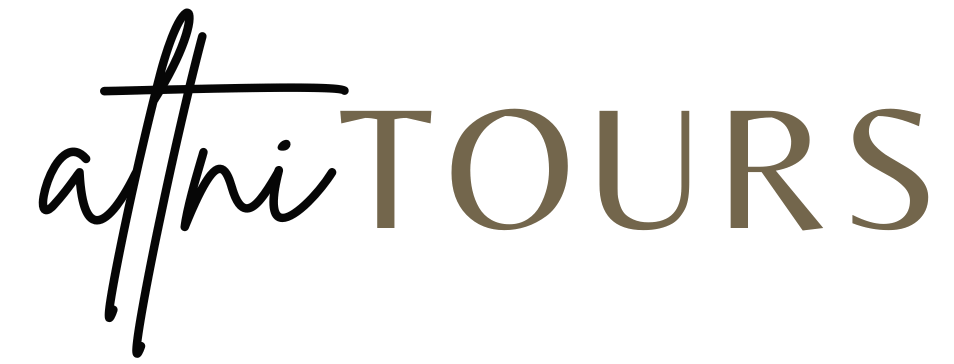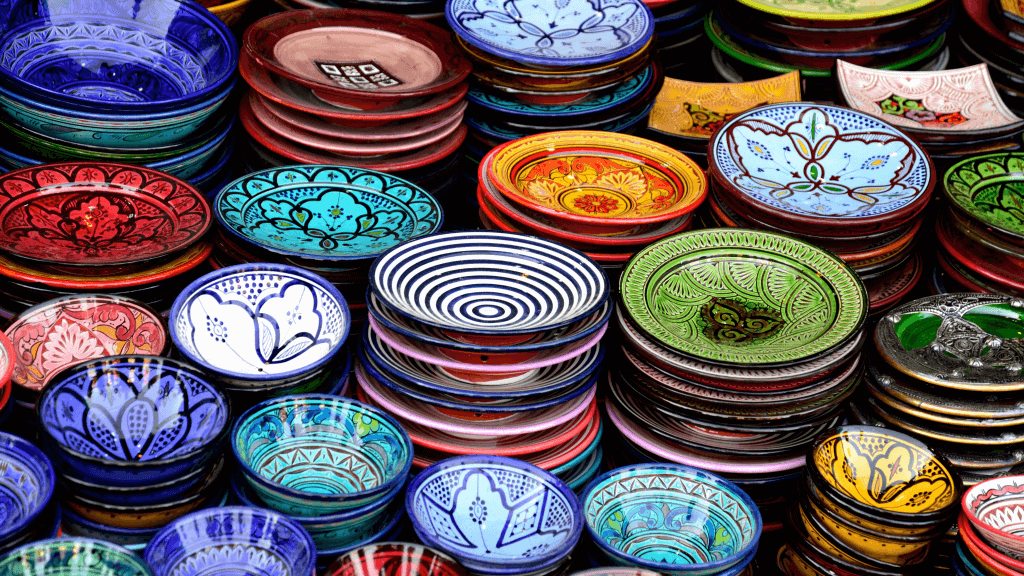Top 15 Souvenirs to Take Home from Morocco | Traditional Clothing, Ceramics & More”
If you’re planning a trip to Morocco, you might want to consider buying some exotic items from the bustling markets known as souks. It would be hard to resist the temptation of exploring these splendid markets and not buying a few souvenirs. The variety of unique artifacts and handicrafts available there is truly amazing!
The Moroccan souks provide a great cultural experience and are similar to shopping at the Grand Bazaar of Istanbul. They offer a sensory overload with vibrant colors, scents, and sounds. The souks are full of beautiful ceramics, colorful textiles, and fragrant spices, making them the perfect place to truly experience Moroccan culture.
Are you searching for souvenirs to take back with you from Morocco?
Morocco offers a plethora of unique items that are perfect as gifts or souvenirs for loved ones back home. From traditional handicrafts to one-of-a-kind culinary delights, there is something for everyone in this North African country. This post will highlight some of the best souvenirs from Morocco, where to find them, and how to choose the perfect one for your family and friends.
Table of Contents
1: Moroccan Traditional Handmade Rugs: An Ageless Tradition.

Moroccan carpets make for a popular souvenir among tourists because of their wide selection of options and affordable prices. Even the priciest rug bought in Morocco would still be less expensive than one bought in the US or Europe.
For generations, Moroccan carpets have been an important part of the nation’s culture and are made by hand. Women in rural areas traditionally produce them using natural materials and dyes to create unique patterns that reflect the region’s history and culture.
Resources and Methods
Mor carpets usually use wool and cotton, but silk can also be included. The fibers are dyed with natural substances like henna, saffron, and pomegranate to achieve vibrant and long-lasting colors. Moroccan rugs are made by tying individual knots onto a loom which results in a thick and durable piece. A variety of designs can be created through knotting, such as the popular diamond pattern found in many Moroccan carpets.
Patterns and Designs
Moroccan carpets are popular for their intricate and bold patterns that often feature geometric shapes and symbols with significant cultural and historical significance. While certain carpets display religious or spiritual patterns, others showcase tribal designs that represent the distinctiveness of the community that crafted them.
You can have Moroccan carpets made to your specific design preferences, choosing from a range of colors and designs. Custom-made carpets are a great option for interior designers and homeowners looking for a one-of-a-kind statement piece that complements their decor.
Cultural Relevance
In Moroccan culture, handcrafted carpets hold significant importance, as many rural villages rely on rug production to earn a living. For generations, women have passed on the knowledge and techniques to make these carpets, which have become an integral part of Moroccan cultural heritage.
2: Moroccan Ceramics: A Reflection of Culture and Artistry.
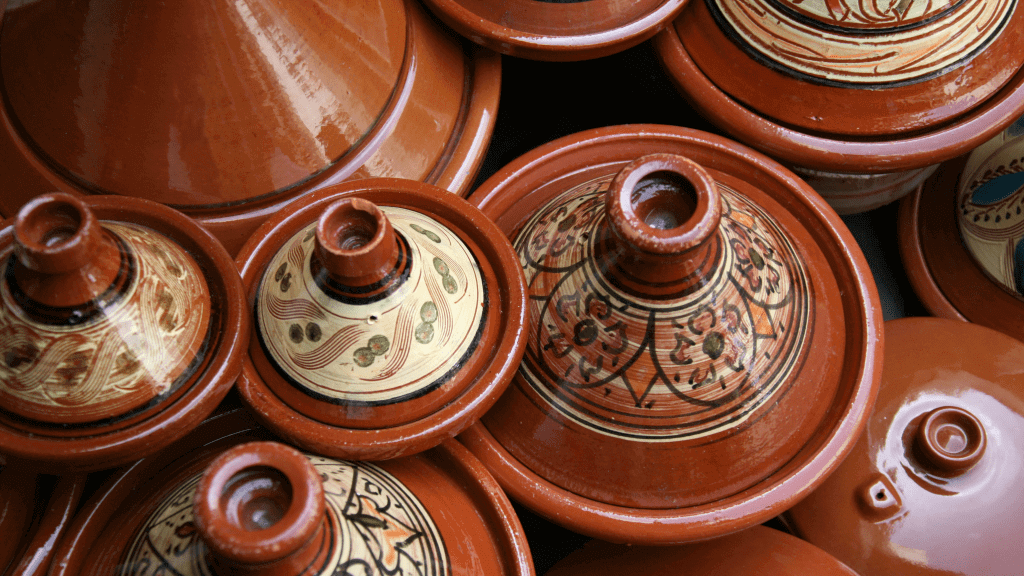
If you’re shopping in Morocco, don’t miss the chance to see the beautiful Moroccan pottery. The intricate designs and bright colors have a rich history dating back hundreds of years, reflecting the influence of Muslim and Spanish conquerors on Moroccan ceramic art.
Morocco is known for its wide variety of ceramic products. The handmade products range from tajine cooking pots to plates, jars, vases, ashtrays, mosaics, bricks, and boxes, each with its unique design, color, and shape. They make great gifts and decoration items, but it’s important to handle them with care as they are delicate.
Moroccan artists showcase their craftsmanship through pottery designs that feature intricate geometric shapes and rich colors, ranging from floral patterns to inventive color combinations. The pottery comes from Safi, Meknes, and Fez – three renowned cities known for their pottery. The ornamental designs draw inspiration from Islamic and Berber cultures and frequently include motifs and geometric shapes used in mosque decorating.
Moroccan ceramics mainly utilize clay and glazes that are made from natural elements such as henna, saffron, and indigo. These materials are responsible for the vivid colors and intricate designs that Morocco ceramics are famous for. The pottery is formed by hand, then painted before being fired in old-fashioned kilns.
Patterns and Designs
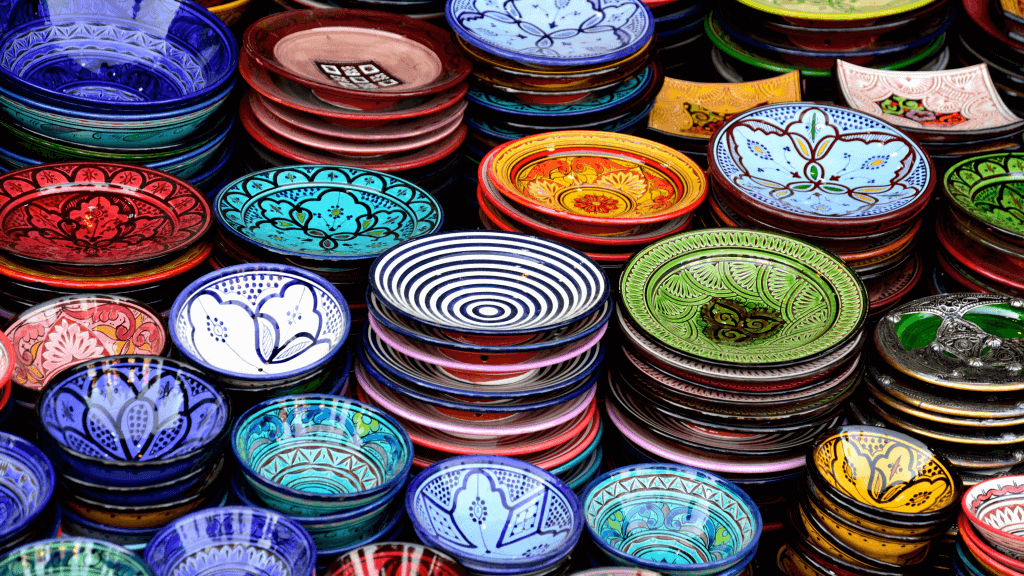
Moroccan pottery is well-known for its intricate designs and patterns that are inspired by the country’s cultural heritage and history. These designs often include geometric symbols such as the eight-pointed star, diamond pattern, and other symbols that have been used in Moroccan art and architecture for thousands of years.
Moroccan ceramics incorporate intricate floral motifs commonly found in Islamic art, as well as other designs and patterns from various civilizations. This creates a unique blend of Moroccan and foreign design elements that help distinguish each piece of clay.
Features and Functions
Ceramic items from Morocco are a popular choice for interior design. They come in various sizes, from small decorative bowls and vases to larger tile murals and architectural accents. Additionally, they can also be used as serving ware and tea sets with practical purposes.
Moroccan ceramics are not only used as household décor but also extensively employed in business settings such as restaurants and hotels. Their exceptional beauty and endurance make them a great option to create a unique and unforgettable environment.
Cultural Relevance
Moroccan ceramics are an important aspect of the country’s culture. They showcase the customs and rich history of the nation and are often used in religious ceremonies and festivals like Ramadan and weddings. These ceramics hold significant value in Morocco’s cultural history.
Best places to buy
Safi, Fez, and Meknes are famous for producing ceramics and patterns with distinct styles and colors that are associated with each city.
3: Leather goods.
When making a list of souvenirs to bring back from Morocco, make sure to include leather goods. They represent the country’s traditional craftsmanship and can be found at different price ranges and levels of quality in Fez and Marrakesh. Keep in mind that Moroccan leather goods have a unique smell.
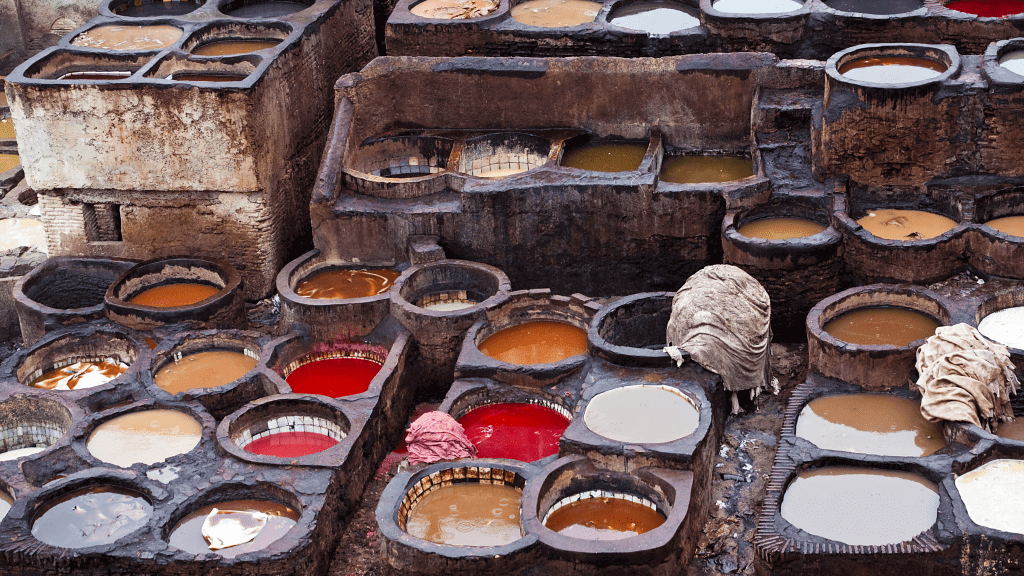
The process of purchasing leather in Marrakech or Fez is similar. Look for a shop that specializes in selling leather or crafting leather goods. Such shops offer reasonable prices and have a personal connection to their products. Don’t hesitate to request something unique, or if you have time, you can even get your own custom-made item.
Usually, getting a custom-made item takes a few days in Morocco, depending on the item’s complexity. However, the cost is lower than in other countries, even if you have to pay extra for faster service. If you have a specific design in mind, it would be helpful to bring a picture or drawing to show the artists.
In Morocco, you can have something custom-made in a few days’ time, depending on what you need. You can even get it faster by paying extra, and it will be more affordable compared to other countries. Make sure to bring a photo or a sketch of your desired item to show the painters.
4: Spices and Herbs.
Moroccan spices have a superior flavor compared to the conventional spices found in North American and European stores. They are also inexpensive and convenient gifts to send home. The commonly bought spices in Morocco are saffron, turmeric, cumin, and ras el hanout. When buying spices, ask if they can be freshly ground for you.
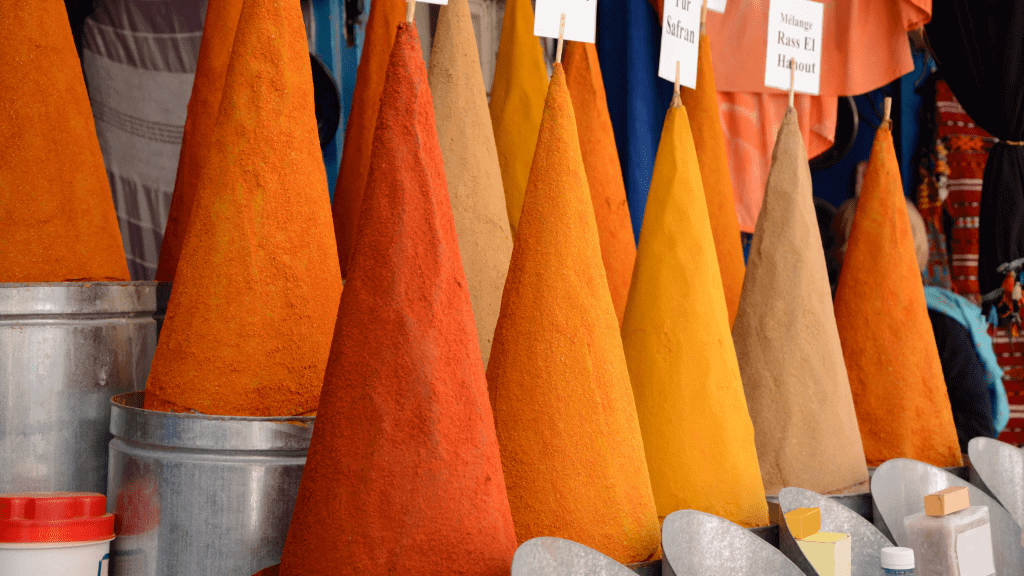
When buying spices in Morocco, it’s important to focus on selecting the ones that you will actually use instead of being tempted by their alluring appearance. Keep in mind that the spices in Morocco have much stronger flavors compared to the ones typically found in grocery stores.
The best places to purchase
You can find spices all over Morocco, but saffron is mainly produced in Tailouine. Keep in mind that the quality of spices might differ based on the region and season. For example, dates are harvested in the Sahara during November and December, while almonds are available in early spring in the northern areas.
5: Clothing.

If you’re interested in buying clothing in Morocco, you’ll find a wide variety of items available. From ornate dresses to simple djellabas, many of these pieces are still made by hand and are priced reasonably. In particular, tunic tops and linen dresses are great options for women. Keep in mind that brightly colored items may bleed during washing, so it’s important to wash them separately at first. Another popular choice is a flowy kaftan, which can be worn at home, outside, or as a cover-up at the pool or beach.
If men want to buy traditional hats or tailored clothing in Morocco, they can find them in the markets with some dedicated exploration. Additionally, they may consider purchasing a thobe, which is perfect for the hot summers. However, it’s essential to be mindful of your personal style when shopping because some items may not be suitable once you return home. Even if you blend in well in Morocco, it’s best to select clothing that is comfortable to wear in both locations.
In addition, it’s important to explore beyond the traditional markets (souks). You can find many modern districts in Moroccan cities that feature boutiques selling items with traditional styles and patterns but with a contemporary twist. These choices are ideal if you enjoy the colorful and intricate design of Moroccan fashion but prefer pieces that you can easily incorporate into your daily outfits.
6: Moroccan Carpets.
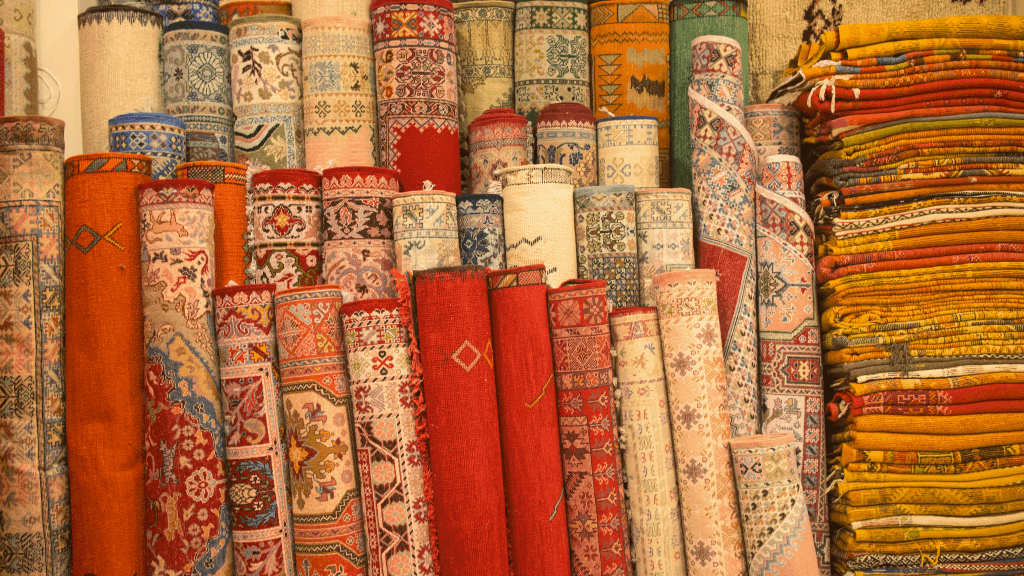
Moroccan weavers use traditional methods to create exquisite carpets known for their distinct patterns, superior craftsmanship, and breathtaking beauty. These carpets are not just decorative but also reflect the rich cultural history of Morocco. Each carpet is a unique work of art that tells a story and showcases the individuality and history of its maker.
How Moroccan Carpets Are Made?
Moroccan carpets are made by hand using wool, cotton, and silk. Although cotton and silk are usually brought in from other places, local sheep’s wool is often used. The wool is cleaned by hand washing, carding, and spinning before it is dyed using natural dyes made from plants and minerals.
Moroccan carpets are made by weaving carefully and for a long time. The patterns can be complex and challenging to create. A weaver sits at a loom and uses a shuttle to pass weft threads over and under the warp threads, repeating this process row by row until the entire carpet is woven.
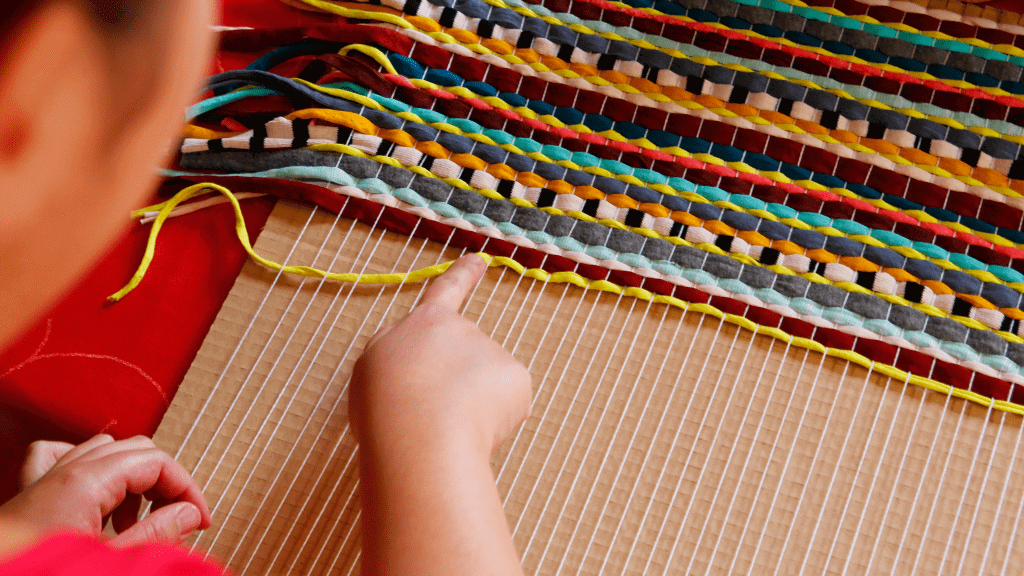
Moroccan carpets have unique designs that are inspired by the rich cultural heritage of the country. Every region of Morocco has its distinct carpet design comprising specific colors, patterns, and motifs. These designs can range from complex floral patterns to geometric shapes. Additionally, the colors used in these carpets also have symbolic meanings. For instance, red signifies power and life, blue represents safety, and green denotes fertility and optimism.
Moroccan carpet uses
Moroccan carpets are beautiful pieces of art that also serve a practical purpose as furniture. They can be used as wall hangings, bedspreads, floor coverings, and even as horse saddle blankets. Moroccan people often give carpets as gifts to celebrate important occasions such as marriages and births.
Moroccan Carpets’ Market Value
Moroccan carpets are highly valued for their beauty, durability, and cultural significance. They are often handed down from one generation to another within families and are considered an important part of Moroccan cultural heritage. People all around the world admire the unique beauty and outstanding workmanship of Moroccan carpets, and they are particularly cherished by collectors and interior designers.
Recently, there has been a surge in demand for Moroccan carpets on the global market, leading to their increased availability. However, as a consequence, the production of cheaper and lower-quality carpets has also risen. Moroccan lanterns have a significant cultural significance and are known for their complex designs and vibrant colors. They serve as both decorative pieces and functional objects in Moroccan households and public spaces.
7: Moroccan Lanterns: An Elegant Fusion of Art and Use.
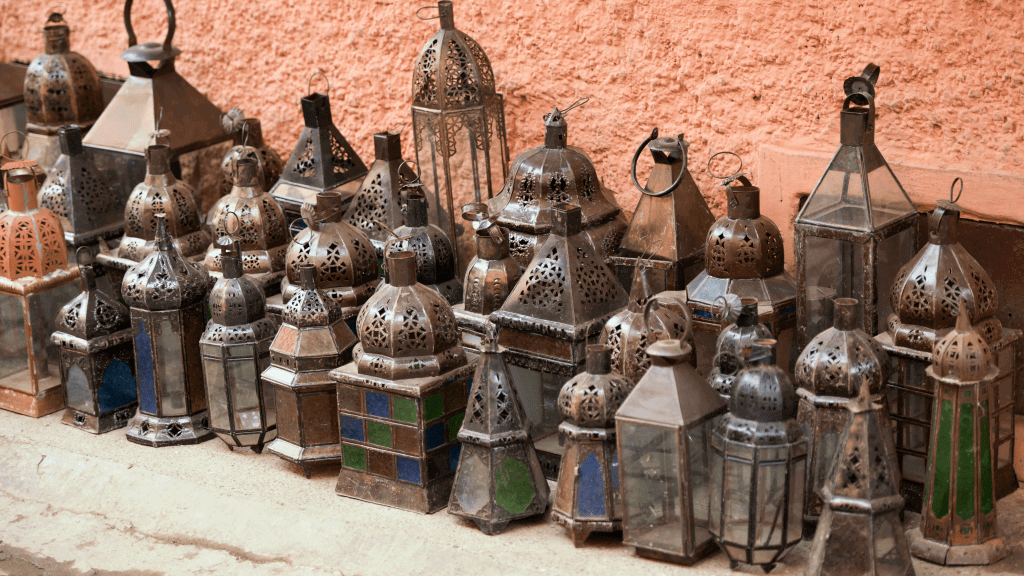
Craftsmanship
Handmade Moroccan lanterns can be crafted using various materials such as brass, copper, and tinted glass. The process involves intricate metalwork, glass cutting, shaping, and assembling. Moreover, each location has its unique design, and the lanterns often symbolize the cultural heritage of their origin.
Functionality
In Morocco, lanterns are commonly used in households and public places for practical purposes. They emit a soft and pleasing light, creating a warm and inviting atmosphere. The glass panels not only protect the flame from wind and other elements but also help in keeping insects away. These lanterns can be placed on tables, used as wall sconces or hung from ceilings, both inside and outside.
Designs and Fashion
You can find Moroccan lanterns in various styles, from classic to modern. Typically, traditional Moroccan lanterns are made from materials such as brass and copper and have intricate geometric designs. Colored glass is often used to add a stunning visual effect when the lantern is lit up.
Modern Moroccan lanterns often feature sleek, simple designs made with contemporary materials such as aluminum and stainless steel. These lanterns may also incorporate modern lighting technologies, such as LED lights.
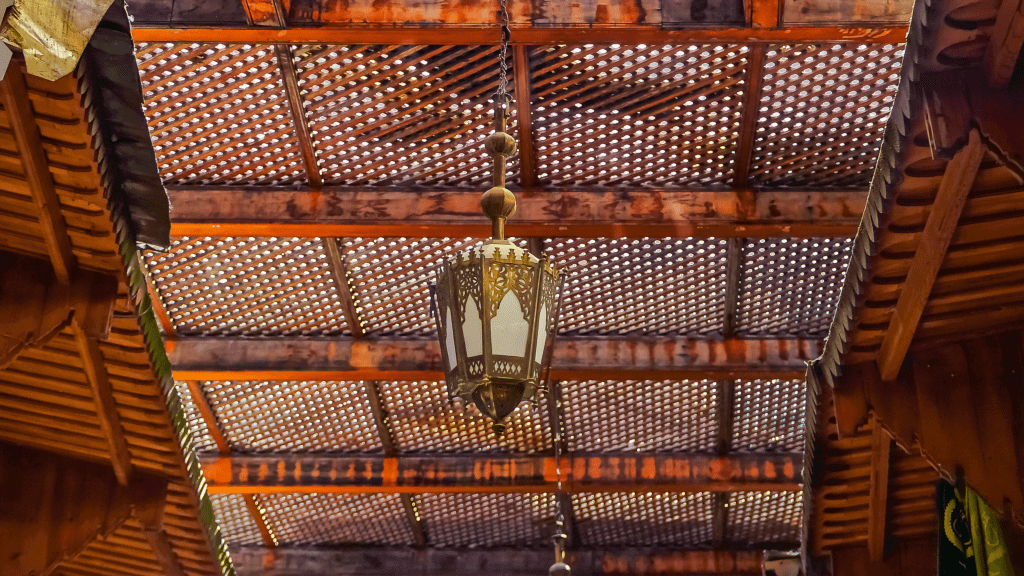
Best sites to purchase:
Although lanterns are generally similar across the country, slight differences may be observed among artisans and various regions.
8: Moroccan Argan Oil: The Liquid Gold of Beauty.

Moroccan Argan oil is a one-of-a-kind oil that comes from the nuts of the Argan tree in southern Morocco. It is prized for its numerous health and beauty benefits and is often called “liquid gold.” Moroccan Argan oil is high in antioxidants, vitamin E, and fatty acids, which is why it’s so commonly used in beauty products. However, it can be quite expensive.
Benefits for Hair
If you have dry, damaged, or frizzy hair, Moroccan Argan oil could be a great solution for you. This oil nourishes and moisturizes your hair, leaving it looking glossy, silky, and healthy. It’s even believed to have properties that can help prevent hair loss and promote hair growth. Many people love using this oil to improve the health and appearance of their hair.
Benefits for Skin
Argan oil is a powerful moisturizer that can effectively hydrate and nourish the skin. Its high concentration of vitamin E has been shown to reduce the visible signs of aging, such as fine lines and wrinkles. Additionally, this oil is believed to have acne-fighting properties and is commonly used in skincare products for this reason.
Culinary Uses
Argan oil from Morocco is not just for beauty purposes – it’s also used in cooking. The oil has a rich, nutty taste and is commonly used as a dip for bread or a dressing for salads. It’s also found in traditional Moroccan dishes like tagines and couscous. Remember that Argan is only made in Morocco, so make sure to get some before you leave. It’s a wonderful memento from Morocco!
9: Moroccan Pottery: A Beautiful and Functional Art Form.

During your trip to Morocco, you will find a wide selection of handmade pottery and ceramics. These include plates, bowls, mugs, and ornaments in a range of colors from vibrant to muted. To find items that suit your taste and budget, take the time to explore the markets. Keep in mind that many of these items are fragile if you plan to bring them back home as souvenirs.
Materials and Techniques
Pottery made in Morocco is usually crafted from locally sourced clay. The shaping process involves using a pottery wheel or traditional techniques such as coil building or slab construction. Once the pottery is formed, it’s left to dry in the sun before being fired in a kiln.
Moroccan pottery stands out for its unique decorations created through carving, painting, and glazing techniques. The designs draw from traditional motifs like geometric patterns and flowers, using materials such as henna, glazes, and metallic pigments.
Functional and Decorative Pieces
Moroccan pottery serves both functional and decorative purposes. It includes everyday tableware like tagines and teapots, as well as ornate decorative objects like vases and plates.
Decorative objects like lamps, lanterns, and candleholders can also be made out of Moroccan pottery. These pieces are typically very intricate, showcasing detailed patterns and designs that produce stunning light patterns and shadows whenever they’re lit.
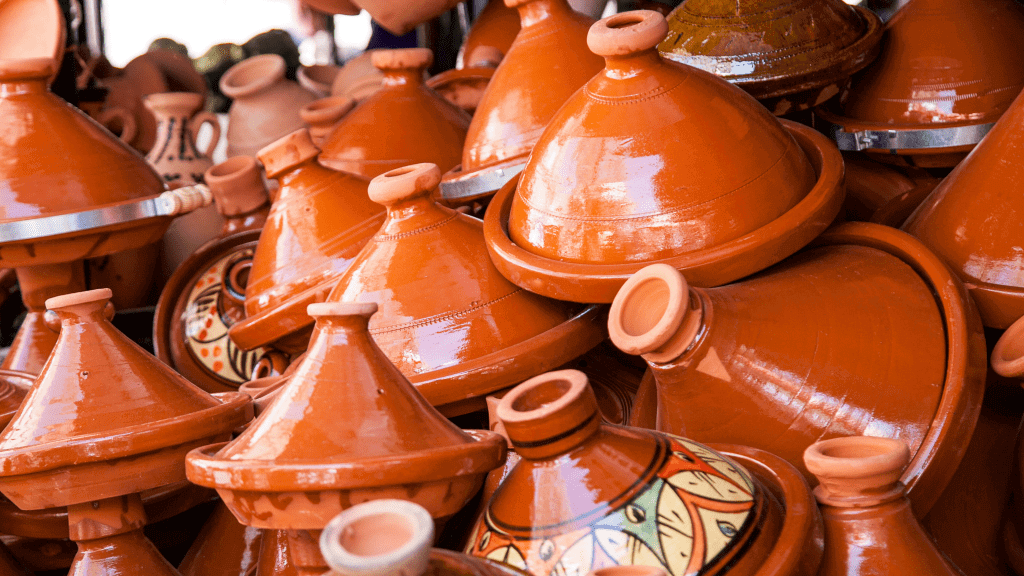
Cultural Significance
In Moroccan society, pottery holds significant cultural value as it is a traditional craft that is handed down from one generation to another. Many families have been involved in pottery-making for centuries. Furthermore, Moroccan pottery plays a crucial role in showcasing hospitality as exquisite bowls and plates are commonly used to serve meals to guests.
10: Tea Sets.
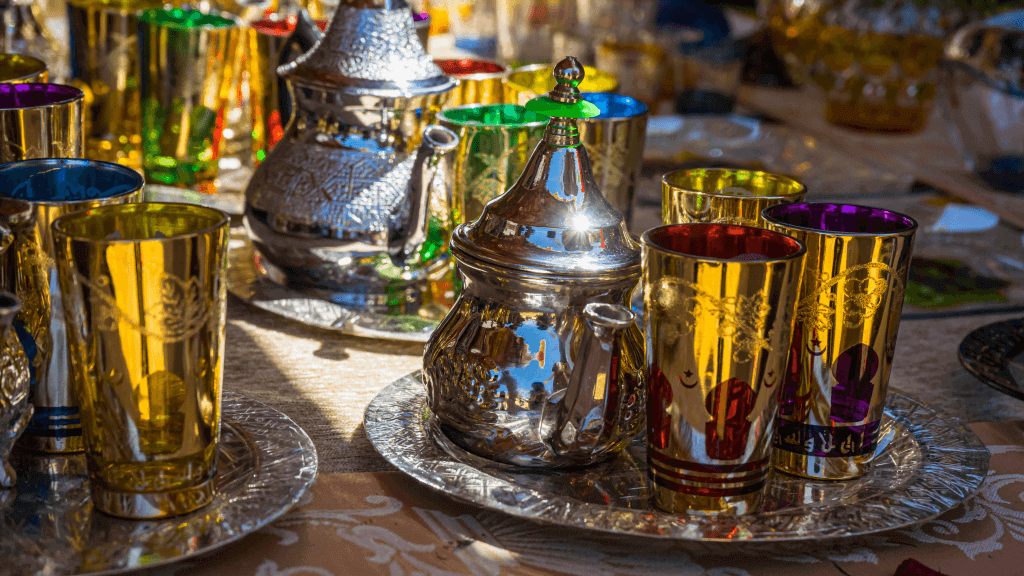
Moroccan tea, also known as “Moroccan mint tea”, is an important aspect of Moroccan culture and hospitality. It is customary for Moroccan hosts to serve tea to their guests, and the type of tea set used can greatly impact the overall experience.
Moroccan tea sets usually feature intricate designs with vibrant colors that celebrate the country’s cultural heritage. These sets typically include a tray, cups, and a teapot, with the cups being small and ornate. The teapot is commonly made of metal like brass or copper and is also decorated with designs. The tea tray is also often adorned with intricate decorations.
Moroccan society holds the act of pouring tea in high esteem. The tea-making process involves steeping fresh mint leaves and green tea leaves in hot water using a unique technique. The crucial part of the tea-serving ritual is carefully pouring the tea into glasses, resulting in a frothy layer on top. This action is known as “the pour.”
Moroccan tea sets have cultural significance as well as being aesthetically pleasing and useful. In Moroccan culture, serving tea is a gesture of hospitality and respect. It is customary to offer tea to guests when they visit a Moroccan home. Along with being served during social gatherings and special occasions, tea is a way for Moroccans to connect with each other.
If you want to buy a Moroccan tea set, there are plenty of options available both online and in specialized shops. When choosing a tea set, look for one that is well-crafted and showcases the stunning patterns and decorations that are characteristic of Moroccan art. Additionally, consider buying a set that includes a tea kettle and tray to have everything you need for an authentic Moroccan tea experience.
If you’d like to experience Moroccan hospitality at home, consider buying a Moroccan tea set and learning how to make and serve Moroccan mint tea. These tea sets are a beautiful and important part of Moroccan culture, representing friendship, connection, and the country’s rich history and artistic skill.
11: Musical Instruments.
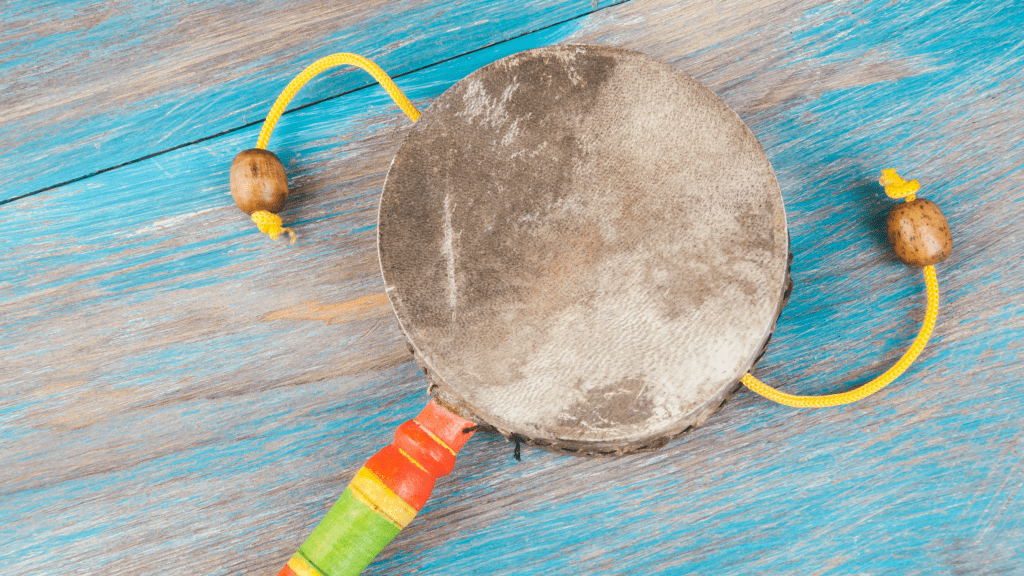
Moroccan music is a great way to experience the country’s diverse cultural heritage. The musical instruments used in Morocco have a unique style and sound and boast a rich history with intricate designs.
The oud is a popular musical instrument in Morocco. It is a stringed lute-like instrument played by plucking the strings with a plectrum made of a combination of wood and other materials. In traditional Moroccan music, the oud is often used to accompany singing.
The crab is a popular musical instrument in Morocco, known as a kind of castanet. To play it, two metal pieces of the qraqeb are held together and struck against each other. The grace is frequently used in Gnawa music, a traditional genre of music originating from Morocco.
The guembri is a popular Moroccan musical instrument that serves as a bass guitar. It can be played using either fingers or a bow and is known for its rich and resonant tone. Additionally, it is frequently used in Gnawa music.
Another popular type of drum used in Moroccan music is called the bendir. This drum is made of a wooden frame and has an animal skin covering. It is played by hitting it with the hands and is often used to accompany singing and other music performances.
Finally, it’s worth noting that in Moroccan music, the nay refers to the common type of flute. Made from a type of reed, it is played by blowing over the instrument’s top. The nay is often featured in traditional Moroccan music.
It is worth mentioning that Morocco has a rich musical history and unique instruments. These include the oud, guembri, qraqeb, bendir, and nay that have played a crucial role in the cultural heritage of the country and are still essential to Moroccan music.
For the best shopping experience, I would recommend visiting Marrakech, Essaouira, and the nearby cities close to the Sahara.
12: Moroccan Slippers (Babouches).
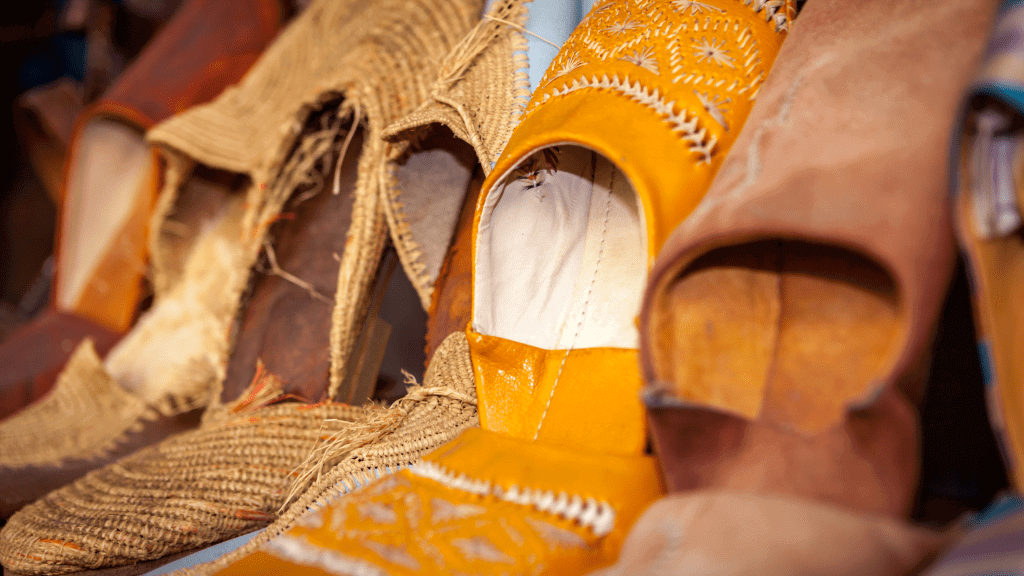
Moroccan slippers, also known as babouches, are a type of footwear that is commonly worn in Morocco and other North African countries. These slippers are made from soft leather and are known for their distinctive pointed shape and colorful patterns.
Babouches, a type of footwear, hold a significant place in Morocco’s culture and have been worn by generations. They can be worn by both men and women and are commonly used indoors as a fashionable and comfortable alternative to traditional shoes.
The shape of babouches is unique and original, featuring a pointed toe that slightly curls up at the end. It is believed that the design was inspired by the footwear of the Berber people, who are indigenous to North Africa. These shoes are often made from soft leather, which has been dyed in various bright colors like red, yellow, blue, and green.
Babouches are known for being both comfortable and durable, as well as for their unique style. The supple leather molds to the shape of the foot, providing a secure and supportive fit. Additionally, they are lightweight and flexible, which makes them ideal for extended wear.
Babouches may be decorated with intricate stitching, as well as adornments such as sequins or pearls. These decorative items can vary in complexity and style, from simple geometric patterns to elaborate floral or animal motifs.
Moroccan slippers, also called babouches, are a timeless type of footwear that hold great cultural significance in the country. They’re a trendy and distinctive choice for those who want an alternative to conventional shoes.
Babouches are shoes with a pointed shape that come in many colorful colors and are known for being very comfortable. They are a symbolic representation of Morocco’s rich cultural heritage and creative traditions and can be worn both indoors and outdoors.
13: Henna Tattoos.
Moroccan henna tattoos are an ancient form of body art that has been passed down through generations in Morocco. The tattoo is created by meticulously applying a paste made from the leaves of the henna plant onto the skin in detailed patterns.
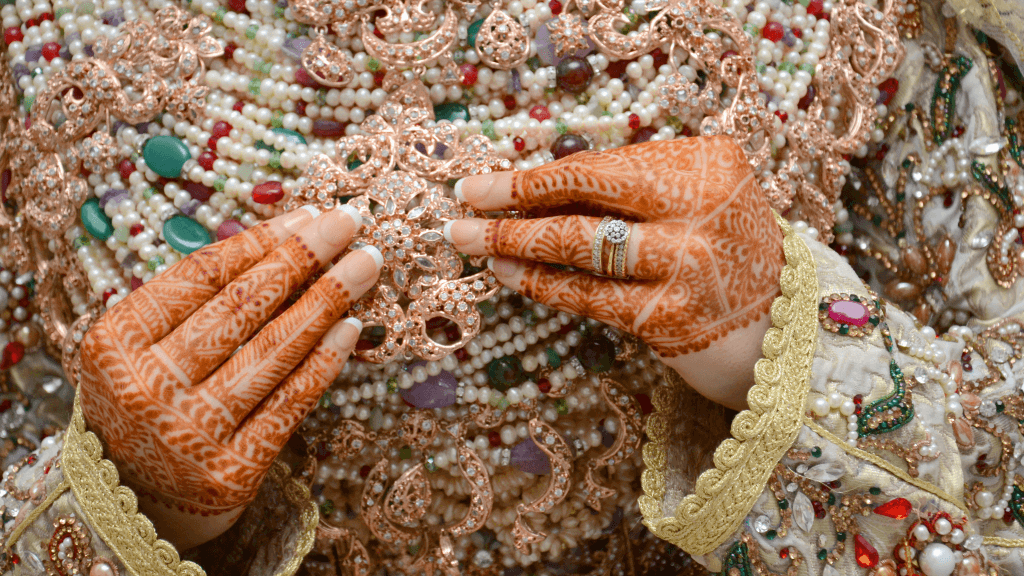
Henna tattoos are an important part of Moroccan culture and are often used to celebrate significant events such as weddings and religious holidays. Many tourists are attracted to these tattoos because of the intricate and beautiful designs that can be created with henna, which is a popular form of body art in the country.
The henna plant, also referred to as Lawsonia inermis in scientific terms, is indigenous to North Africa and the Middle East. The plant’s leaves are dried, ground into a fine powder, and mixed with water to create a paste. This paste is applied to the skin using a cone-shaped applicator to create intricate designs and patterns.
Henna tattoos are temporary and usually have a lifespan of around two weeks. The duration of the tattoo largely depends on the quality of the henna paste applied and the individual’s skin type.
In Moroccan culture, hands and feet hold a lot of importance, and that’s why henna tattoos are commonly applied to them. Typically, henna tattoos feature various styles, but traditional Moroccan designs usually consist of floral themes and geometric patterns.
Henna tattoos hold cultural and spiritual significance in Morocco apart from being visually appealing. They are commonly sported to mark significant occasions such as weddings or religious festivals. These tattoos are believed to bring luck and prosperity to the person wearing them.

Over the years, henna tattoos have become increasingly popular worldwide. They serve as a way for people to display their individuality and connect with different cultures through traditional body art.
Moroccan henna tattoos are an intricate and beautiful form of body art that have been well-liked in Morocco for many years. They have a significant role in the country’s cultural heritage and are often used to celebrate important occasions and festivals. Interestingly, henna tattoos still fascinate and motivate people worldwide. They can be either a traditional style or a modern way of self-expression.
14: Camel Leather Products.

In Morocco, there is a long-standing tradition of using camel leather to create many different types of items, such as purses, shoes, and clothes. These products are a testament to the country’s cultural and creative heritage.
Camel leather is a highly durable material that is ideal for items that need to withstand rough usage. It also features a unique texture and appearance that sets it apart from other types of leather.
Moroccan artists are known for creating intricate patterns and designs using camel leather that are both visually appealing and functional. Many of these artists come from families with a long history of making leather goods and have passed down their knowledge to future generations.
Camel leather bags and purses are popular products in Morocco. They are often decorated with intricate stitching and embellishments, making them both stylish and practical. These items are highly favored by both locals and tourists.
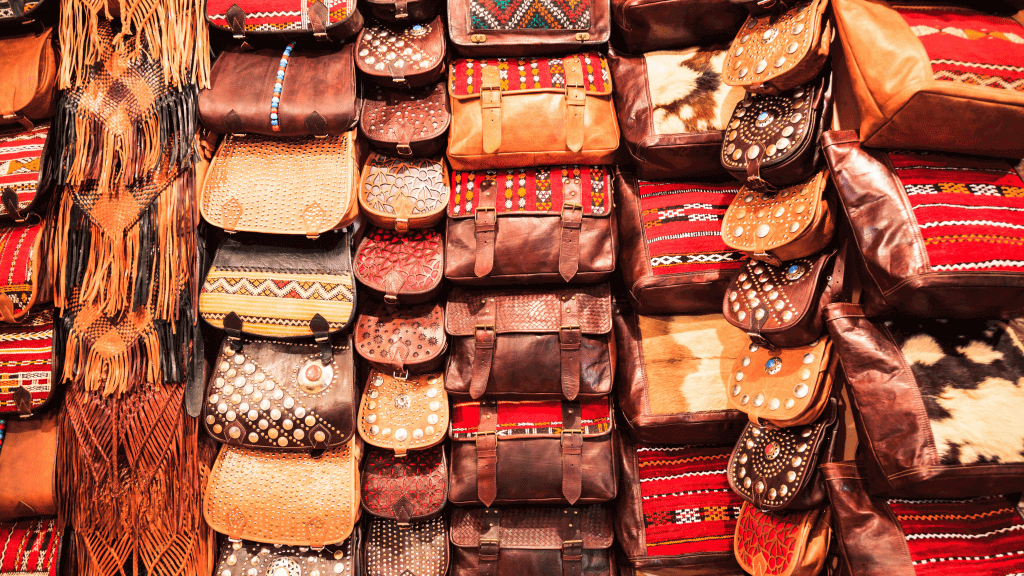
In addition to bags, camel leather is also used to make shoes, clothes, and the traditional Moroccan slippers called babouches. These items are often handmade and crafted with care and attention to detail.
Marrakech is a city in Morocco known for its lively market called the souk, where visitors can find a wide range of camel leather products such as purses, shoes, belts, and coats. It is one of the most popular destinations to purchase these items.
To summarize, Moroccan goods crafted from camel leather showcase the country’s vibrant cultural heritage and artistic abilities. They are highly coveted by both residents and tourists due to their durability, unique texture, and attractive designs. These products are a genuine reflection of Morocco’s dynamic and diverse culture, whether they serve a practical purpose or as a trendy fashion accessory.
15: Decorative Metalwork.
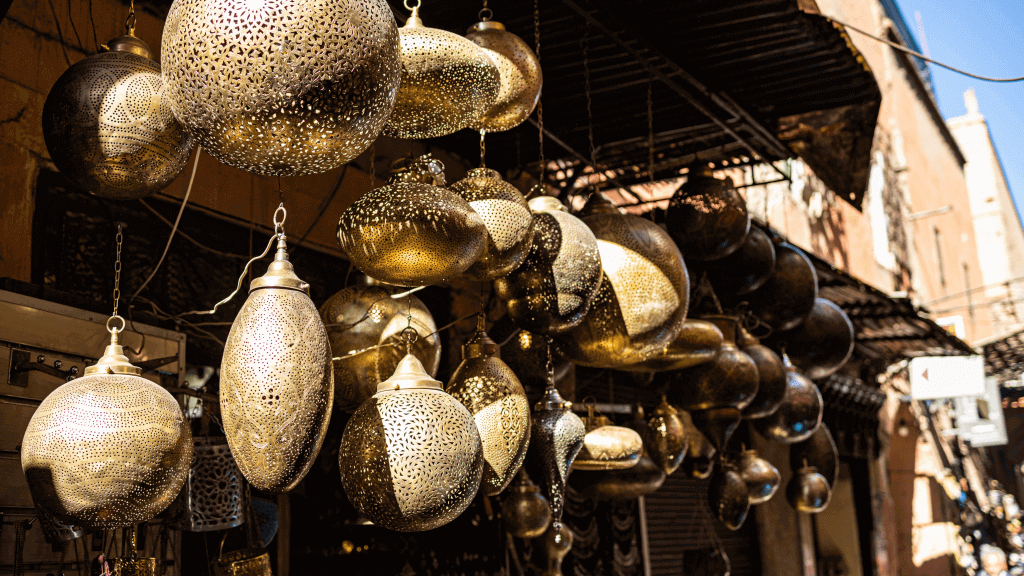
Moroccan metalwork is an ancient art form that is still thriving today. It features intricate patterns, bright colors, and impressive craftsmanship. Talented artists continue to create a wide range of stunning and functional metalwork products that play an important role in Moroccan culture.
Moroccan decorative metal pieces are varied and can include furniture, trays, lamps, and mirrors. They are often made of brass, copper, or iron and are adorned with intricate patterns such as florals and geometric shapes. These designs are often influenced by Islamic art and architecture, which is evident in the intricate tilework and calligraphy found throughout Morocco.
Moroccan metalcraft designs often feature lanterns, which are popular for decorating both homes and public areas. These lanterns are made by adding layers of colored glass to metal frames, creating intricate patterns and beautiful hues result is a stunning work of art that enhances the ambiance of any room while also providing illumination.
Moroccan metalwork includes trays that are often used to serve food and beverages. These trays are made of brass or copper and are decorated with intricate designs to display the artist’s skill and precision. Some of these trays are even more luxurious and unique as they are adorned with precious stones and other decorations.
In addition to ornamental elements, Moroccan metalwork also includes useful products, such as furniture. Tables and chairs made from metalwork are commonly found in Moroccan homes, featuring elaborate patterns and motifs that enhance the overall aesthetics while also serving practical purposes.
Moroccan ornamental metalwork is a true reflection of the country’s rich cultural and creative traditions. It is characterized by intricate designs, vibrant colors, and exceptional craftsmanship. From lanterns and trays to furniture and mirrors, Moroccan metalwork comes in diverse forms. Whether used for practical purposes or decorative purposes, Moroccan metalwork displays the country’s dedication to preserving its cultural identity and artistic legacy.
Morocco’s Top Shopping Locations
Many people ask us about the best shopping spots in Morocco and whether there will be enough time to shop during our guided tours.
FAQ
Are Moroccan souvenirs expensive?
The cost of Moroccan souvenirs varies depending on the item and the region. Many souvenirs are handmade and of high quality, which may increase their price.
Is it acceptable to bargain when purchasing souvenirs in Morocco?
In Morocco, bargaining is a common practice. However, it is important to be respectful and polite during the bargaining process.
Is it worth buying Moroccan carpets considering their cost?
Moroccan carpets are often handmade and of very high quality. They have a unique style and can last a long time, making them a smart purchase.
Am I allowed to bring Moroccan spices back home with me?
It’s important to check your country’s customs policies beforehand.
Is it safe to use candles with Moroccan lanterns as intended?
It is important to follow the manufacturer’s recommendations and be cautious.
What are some traditional gifts from Morocco?
Some examples include Moroccan leather poufs, tea glasses, Kamsah handcrafted and painted tagine pots, Moroccan black soap, Mina Harissa hot sauce, vintage candle holders from Morocco, organic argan oil, and handmade Moroccan teapots.
These gifts are emblematic of the country’s cultural and historical legacy and are typically bought in the souks or markets found in Morocco’s old cities and medinas. They make for distinctive and genuine gifts that are sure to please anyone who has an affinity for Moroccan artistry and handiwork.
Which spices are recommended to buy when visiting Morocco?
Moroccan cuisine relies heavily on ten essential spices including black pepper, aniseed, sesame seeds, cumin, paprika, cinnamon, turmeric, ginger, cayenne, and saffron.
These spices are commonly used in both savory and sweet dishes, and are integral in creating the flavorful and mouth-watering meals that represent Moroccan cuisine. If you want to bring a bit of Morocco to your home, you should stock up on these spices which are available at various marketplaces and souks throughout the country.
What can I bring back from Morocco to the US?
Ceramics: Moroccan ceramics and pottery are well-known for their striking patterns, especially those that combine blue and white. Spices include the well-known Moroccan spice combination Ras El Hanout as well as single spices like cumin and saffron.
Moroccan lanterns are elegant, and gorgeous, and make for a distinctive decorative piece. Moroccan tea sets are great for enjoying tea in style as they are often adorned with intricate designs. In Morocco, you can find argan oil, a popular cosmetic product made from the oil of the argan tree, at many stores and markets. Traditional Moroccan slippers called babouches are available in various colors and designs and are perfect for relaxing at home. Berber weavers produce carpets known for their bold patterns and bright colors.
We suggest shopping at the souks in the medinas or old cities of Morocco, such as Fes and Marrakech, as they offer great shopping opportunities. Don’t worry, we have factored in enough time for shopping during our trips.
On the tour, you’ll visit places where the goods are made and can purchase souvenirs. If you see something you like while passing by, you can ask to stop and check it out. This is a benefit of a private tour.
